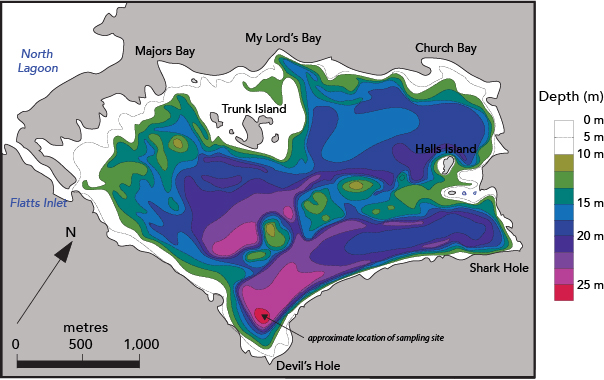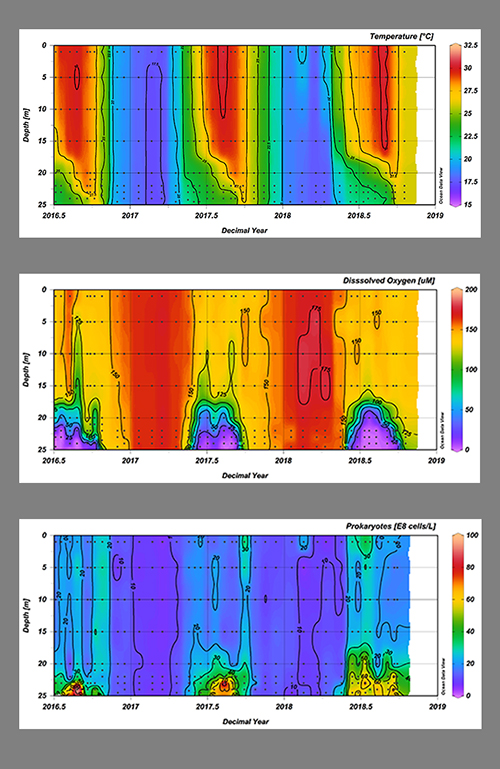Microbial and Biogeochemical Processes at Devil's Hole
Once a subterranean oceanic cave fed by the Atlantic Ocean, Devil's Hole eventually collapsed and is now a large water-filled sinkhole. Prior to its collapse, Devil's Hole was one of the island's most popular (and oldest!) tourist attractions, serving as a natural aquarium and offering up close views of Bermuda's indigenous marine life. Since the 1950s scientists from around the world have studied a variety of natural marine processes and organisms in Devil's Hole, including carbonate sedimentation, the ecology of boring sponges, and nutrient flux of sediments. Today, Devil’s Hole forms a natural laboratory that scientists are using to understand how marine organisms and sediments are responding to changing physical and chemical seawater conditions.

A bathymetric map of Harrington Sound. Taken from Bates et. al (2017) and adapted from Neuman (1965) and Andersson et al. (2007)
Each year Devil's Hole undergoes reliable transitions: there is a period of summer stratification that causes lower waters to be seasonally hypoxic (low in oxygen), followed by an overturn during the winter months during which the entire water column returns to typical oxygenated waters. As a result, observations of bacterioplankton in Devil's Hole can demonstrate how the community changes in response to low pH and O2 and increased levels of pCO2. Researchers are particularly interested in bacterioplankton and associated microbial processes because they are believed to be of increased importance as ocean surface warming creates more numerous and more frequent oxygen minimum zones.
In 2008 the temporal dynamics of bacterioplankton communities were analyzed at Devil's Hole, Bermuda during the 6-week annual transition from a strongly stratified water column with suboxic and high-pCO2 bottom waters to a fully mixed and ventilated state. During stratification, the oxygenated surface waters were dominated by the SAR11 clade and the cyanobacterium Synechococcus. In the suboxic bottom waters, Chlorobiales prevailed. These autotrophs use sulfide as a source of electrons for photosynthesis. The abundance of the ammonia-oxidizing Thaumarcheota and the methane producing Euryarcheota were elevated in the suboxic bottom waters. Following convective mixing, the entire water column returned to a community typical of oxygenated waters.
The results of this study have been published in Environmental Microbiology:
Parsons, RJ, Nelson, CE, Demnan, CC, Andersson, AJ, Kledzik, AL, Vergin, K, McNally, SP, Treusch, AH, Carlson, CA, and Giovannon, SJ. (2014) “Marine bacterioplankton community turnover within seasonally hypoxic waters of a sub-tropical sound: Devil¹s Hole, Bermuda.” Environmental Microbiology DOI: 10.1111/1462-2920.12445.

Contour plots showing the Temperature (°C), Oxygen levels (uM) and Bacterial abundance (x10^8 cells per L) from July 2016 to October 2018. As the air temperature increases, the water column becomes stratified with warmer temperatures at the surface (red) and cooler at depth (green). At this time dissolved oxygen levels decrease below 20m (purple) as a result of cellular respiration by increased bacteria (red/orange). This happens every summer in Devil’s Hole. During the Fall, their temperatures decrease and the stratification is overturned from storms causing a uniform water column with lower temperature (blue), high oxygen levels (red) and low bacteria (blue).
Devil's Hole Interns 2016-2020
Petra Byl: National Science Foundation (NSF) Research Experiences for Undergraduates (REU) 2016 (University of Chicago)
Amber Reid: BIOS Bermuda Program 2017
Lana Fabia: Lehigh University Intern 2018
Julia Skrapits: Lehigh University Intern 2018
Lakshmi Magon: BIOS Bermuda Program 2018
Gillian Palino: NSF REU 2018 (University of Florida)
Alec Weaver: NSF REU 2018 (Oregon State University)
Dane Jacobson: Princeton Intern 2019
Isaiah Calhoun: NSF REU 2019 (Georgia Highlands College)
Lakshmi Magon: BIOS Bermuda Program 2020
Additional research done at Devil's Hole includes:
Andersson, AJ, Bates NR, and Mackenzie, FT. (2007) "Dissolution of Carbonate Sediments Under Rising pCO2 and Ocean Acidification: Observations from Devil's Hole, Bermuda." Aquatic Geochemistry 13(3): 237-264.
Bates, NR. (2017) "Twenty Years of Marine Carbon Cycle Observations at Devil's Hole Bermuda Provide Insights into Seasonal Hypoxia, Coral Reef Calcification, and Ocean Acidification." Front. Mar. Sci. 14. https://doi.org/10.3389/fmars.2017.00036
Project Contact
Rachel Parsons
Research Specialist, Microbial Ecology Laboratory
Rachel.Parsons@bios.edu
Tel: 441-297-1880 x726
Project Team
Professor Nicholas Bates
Senior Scientist and Director of Research
Nick.Bates@bios.edu
Related Items
Microbial Ecology Laboratory
Marine bacterioplankton succession and subsequent overturn within seasonally hypoxic waters of a subtropical sound; Devil's Hole, Bermuda (Byl et al. ASLO poster)
